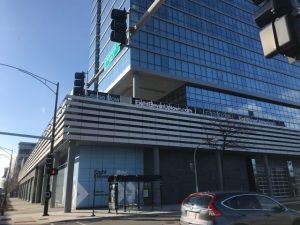
Those concerned with the growing incidents of youth violence in Chicago should pay close attention to what University of Illinois at Chicago’s Associate Professor Von Eugene Nebbitt said while addressing a group of Chicago media and youth convened by the Community Media Workshop at Columbia College on June 28.
“Youth violence is a public health issue. Just like any other epidemic, disease, virus or bacteria, they love places that offer them conditions to live,” said Nebbitt, who grew up in a “pretty awful place” where violence and hostility was just a regular way of resolving conflict.
He was shot twice, went to prison three times, and faced six felony convictions by the time he was 29.
“I was using drugs and alcohol. I was using anything that kind of numbed it and allowed me to continue to participate in this kind of insane reality,” said Nebbitt. “It was a vicious cycle. The more victimization and substance abuse I experienced, the more I perpetrated this kind of violence and insanity in my own community.”

Violence involves concentrated poverty, hopelessness, lack of opportunities and what, according to Nebbitt, is called in the research lingo “alternative market activities.”

“It’s just a fancy word for selling drugs, selling anything in a neighborhood to make
money, which also increases the amount of violence in that neighborhood,” he said.
Referring to a study he has been working on for several years, Nebbitt said the children who experience violence at the community or family level engage in sex and risky behavior at an early age and are more likely to perpetrate violence.
“Kids who live in a cohesive community are less likely to engage in violence,” he said.
Compared to white, school-aged kids, African-American youth are 10 times more likely and Hispanic youth are six times more likely to be murdered, according to a report prepared by the Strengthening Chicago’s Youth.
Strengthening Chicago’s Youth is a youth violence-prevention initiative by the Ann & Robert H. Lurie Children’s Hospital in Chicago. The study reported 433 violence-related deaths in Chicago in 2011, and noted a 38 percent increase in homicide cases as of June 17 this year.


Rob Castaneda who runs Beyond the Ball, a sports-based youth and community development organization in Little Village, was also invited to speak. He shared his story of standing up in his community and making a difference in the face of danger of violence. Castaneda believed change could be made through sports.
“Sports is an amazing vehicle to teach youths lots of great things. We build relationship through sports, and leverage those relationship to create change in the community,” he said.
Following the speeches, participants were invited to meet with over two dozens violence-prevention organizations and experts in speed interviews and gain an insight on the work of those involved in preventing youth violence.
“Our goal is to help Chicago’s news media tell the whole story about youth violence, and to know where and how to get the information from those closest to what’s happening,” said Chicago Media Workshop‘s senior trainer Diana Pando in an email.
Nebbitt called for a multi-systemic approach encompassing, among other things, watching over the communities, intervening at the family level and promoting resilience to the outbreak of violence.

“This would allow youth to be able to bounce back and beat the odds in situations where the likelihood of going to the prison, being shot or ending up shooting someone is very high,” he said.
He said even though it may seem an insurmountable problem, a lot can be done.
“I see myself as an evidence. I never thought that I would ever be able to graduate from high school. Now I have a PhD.”

Related articles
 Media, advocates discuss reporting of youth violence(austintalks.org)
Media, advocates discuss reporting of youth violence(austintalks.org)













Be First to Comment